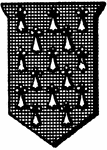
Ermines Shield Fur
A shield or escutcheon emblazoned with the fur, ermines, represented by argent (silver) ermine spots…
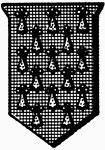
Pean Shield Fur
A shield or escutcheon emblazoned with the fur, pean, represented by or (gold) ermine spots on sable…

Ostrich
"Struthio camelus, the Ostrich or "Camel-bird" of North Africa now extends from Barbary to Arabia, and…
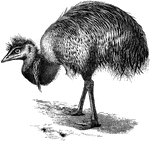
Emeu
An Emeu "Dromaeus novae-hollandiae, of the interior Eastern Australia, which extended in times past…

Great Northern Diver
The Great Northern Diver, Colymbus glacialis, "...is black above, with belts of white spots making a…
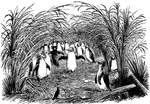
A Troop of Crested "Maccaroni" or Rock-Hopper Penguins Nesting Under the Shade of Tussock of Trees
This is a troop of crested "Maccaroni" or Rock-hopper penguins nesting "under the shade of tussocks…
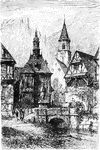
Black Forest Village
View of a village in the Schwartzwald, or Black Forest. The Black Forest stands in the elbow formed…
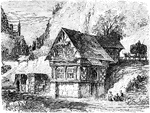
Peasant's House in the Black Forest
View of a peasant's house in the Black Forest. The scene includes an ox cart loaded with hay, children…

Chamois
The chamois (Rupicapra rupicapra) is a goat-like animal, living at moderately high altitudes and are…
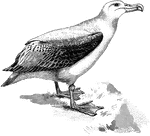
Wandering Albatros
"The Wandering Albatros of the Southern Oceans is white with narrow dusky undulations above and almost…

Storm Petrel Swimming with Reflection
The storm Petrel "of the Mediterranean and North Atlantic from Greenland to South Africa, which breeds…

Tropic Bird Sitting on a Ledge
The Tropic Bird " are chiefly found in the tropical regions of the south; ... this species breeds as…

Gannet
"The Gannet (S. bassana) has slate-grey wing-quills, purplish-grey bill, reddish feet and naked parts."…

Cormorant
The Cormorant "P. carbo, but has a tuft of long narrow recurved plumes on each side f the crown in the…
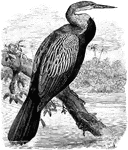
Indian Darter
"The Indian Darter (Plotus melangaster) or snake-bird of tropical and subtropical America, ranging northwards…
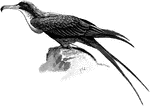
Frigate Bird
"The Frigate pr Mana-of-War-Bird... is met throughout the tropical regions, breeds in Laysan and has…
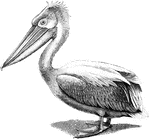
Crested Pelican
"The Crested Pelican or (Pelecanus crispus) is white with rosy or salmon tinge, the primaries being…

Common Heron
"The most typical forms of Ardea (Common Heron) are large slaty-coloured birds, varied by black, rufous,…
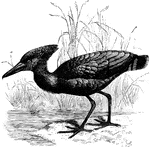
Hammerhead Standing Near Water
"Scopus umbretta, the Hammerhead, of Madagascar and a large part of the Ethiopian Range, is purplish-brown,…
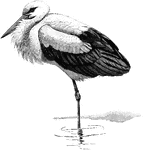
White Stork
"Ciconia ciconia, the White Stork, ...is white with black wings and orbits, red bill and feet." A. H.…

Spoonbill Standing on One Leg
"Platalea leucorodia, the Spoonbill, has white plumage, with bare lores, orbits, and throat, and a fine…
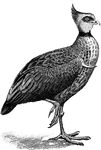
Northern Screamer
"Chauna Cristata, Northern Screamer, is dark grey, with a black ring around the neck and whitish-grey…
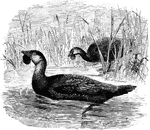
Two Musk Ducks Swimming between the Tall Grass in a Lake
Biziura lobata, (Musk Duck) of Tasmania and Australia -except the north-is brown with buff mottlings,…
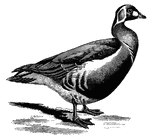
Red-breasted Goose
Bernicla ruficollis, the Red-breasted Goose of West Siberia, which migrates southwards, strays to Britain…
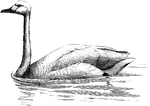
Bewick's Swan
"Cygnus bewicki, Buck's Swan, is white with black feet and bill, the basal half of the latter being…
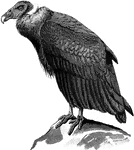
Condor
"On the Sarcorhamphus gryphus the Condor, the head and neck are bare, with dull red skin, wrinkled in…
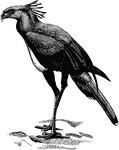
Secretary Bird
"Standing some four feet high on very long legs, this bird (Secretary Bird) gives the impression of…
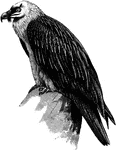
L&emumlmmergeier
"Gypaëtus barbatus, the magnificent L&emumlmmergeier, is greyish-black with white streaks, and has…
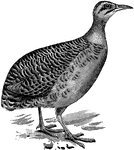
Red-winged Tinamou
"Rhynchotus rufescens,... is grey-brown, with blacker crown, rufous cheeks, neck, and breast, and chestnut…
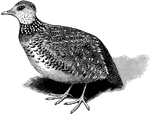
Plain Wanderer
Pedionomus torquatus differs in structure from Turnix by the presence of a small hind-toe. The lax upper…
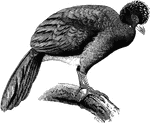
Crested Curassow
Crax alector, Crested Curassow, is black with a purplish gloss, the belly being white, the naked lores…
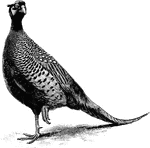
Pheasant
"Phasianus colchicus, Pheasant, ...has a white collar and slaty lower back with dark green barring;…
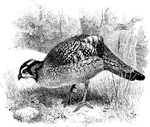
Cabot'sTragopan
"Ceriornis caboti, (Cabot's Tragopan) of South-East China has the latter region buff. The hens are black…
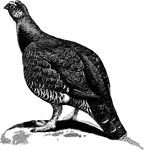
Red Grouse
"Lagopus scoticus, the Red Grouse or Muirfowl, the only bird entirely confined to our islands, differs…

Hoatzin
"The Hoatzin (Opisthocomus cristatus) is curious and highly specialized. "The body is long and thin,…
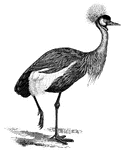
Crowned Crane
"Balearica pavonina, the "Crowned" Crane of the Northern Ethiopian Region, is greenish-black above and…
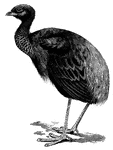
Trumpeter
"Psophia crepitans, the Agami, ranging from British Guiana to Amazonia, is a black bird with velvety…
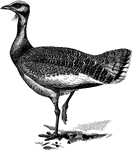
Great Bustard
"The Otis Tarda, the Great Bustard, which, as a native only became extinct in Norfolk about 1838, used…
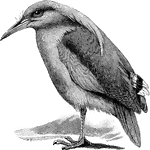
Kagu
"Rhinochetus jubatus, the Kuga ... has powder-down patches that are profusely distributed over the whole…

Sun-Bittern
"Eurypyga helias, Sun-Bittern, has a black head, with a white stripe above and under each eye, and a…
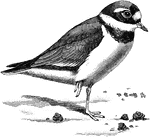
Ringed Plover
"Aegialitis hiaticola, the Ringed Plover, Sand-Lark, or Stone-runner, mistakenly called the "Ring-Dotterel"…
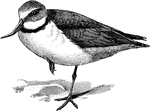
Wry-bill
Anarhynchus frontalis, the Wry-bill of New Zealand, is grey, with a black gorget and whitish lower parts;…

Woodcock
"Scolopas rusticula, the well known Woodcock, brown, grey, and buff in color, with blackish vermiculations…

Indian Jacana
"Hydrophasianus chirurgus, the Indian Jacana, of most of the Indian Region, is Bronzy-brown above and…
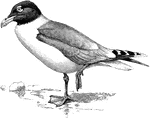
Great Black-Headed Gull
"Larus ichthyaetus, the Great Black-headed Gull, ranging from the Black Sea and the Levant to Tibet,…

Pallas's Sand Grouse
"Syrrhaptes paradoxus, Sand-Ground, are true desert birds, affording excellent instances of protective…

Dodo
"The Dodo, ...was an immense Pigeon-like bird bigger than a Turkey, with an aborted keel to the sternum…

Tooth-Billed Pigeon
Didunculus strigirostris, the Manu-mea or Red Bird of the islands of Upolu, Salvai, and Tutuila in Samoan…

Crowned Pigeon
"Goura coronata, the Crowned Pigeon, discovered by Dampier in 1699, is bluish-slate -coloured, with…
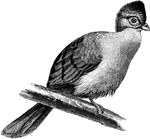
Green-Mantled Turaco Sitting on a Tree Limb
"The Gallirex chlorochlyamys, Green-mantled Turaco, has a general coloration of metallic blue and green…

Uvaean Parakeet
The Nymphicus uvaeesis, Uvaean Parakeet, has a dark coloured face, black beak, green plumage and crest,…
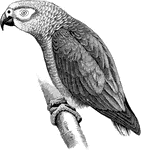
Grey Parrot
"Psittacus erithacus, the Grey Parrot, which ranges across Equatorial Africa, is ashy-grey, with black…

Kirombo
"Leptosoma discolor, the Kiromobo or Vorondreo of Madagascar, and the Comoro Islands, which has a big…

Motmot
"Momotus brasiliensis, the Motmot, from Guiana to Northern Brazil, is somewhat similar in colour (to…

Racquet-Tailed Kingfisher
"Tanysiptera, the Racquet-tailed Kingfisher or "Paradise Kingfisher", the sexes may be similar or dissimilar,…
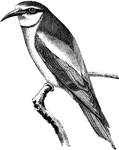
Bee Eater
"Merops Apiaster, the Bee-eater, has ruddy-brown head, neck, upper back, and broad alar bar, buff lower…
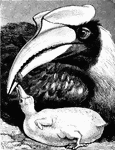
Female Hornbill Laying Down Feeding Her Young
"Dichoceros bicornis of India and the Malay countries has a large yellowish-red casque, hallowed and…

Hoopoe
"Upupa epops, not unfrequently visits Britain, where it has nested on several occasions; it breeds from…
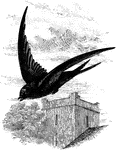
Common Swift Flying Through the Air by a Structure and a Tree with its Mouth Open
"The coloration of the twenty or more species of Cypselus is sooty-black or mouse-brown, frequently…

Long Tailed Hummingbird
"Aithurus polytmus, the Long-tailed Hummingbird, peculiar to Jamaica, the two tail-feathers next to…